Rachel Brown presenting BREEZE at Havlunsj November 10th.
Salmon lice is one of the biggest problems
Lice treatment in particular has become a part of the routine for fish farmers and their salmon. According to the Fish health report published by the Norwegian Veterinary Institute this year, mechanical injuries related to delousing was one of the most significant health problems for salmon in fish farming in 2021.
The report states that from 2016 to 2021 the development of salmon lice treatments has moved in the direction of increased use of methods that demands more handling of the fish. While medical methods are perceived to be better for the fish than non-medicinal treatments, increased resistance, and the impact on the environment has decreased the use of medical driven methods.
New treatment concept
However, despite the mentioned development of the use of medical methods, one of our members, Aqua Pharma, are working with a new anti-sea lice treatment to help make aquaculture more sustainable.
The BREEZE initiative is a collaboration with Pulcea and NTNU, and it combines existing hydrogen peroxide treatment with sonic technology to increase the effect of the treatment. Aqua Pharma delivers the chemical compound and the Scottish innovator, Pulcea, has developed the technology that is used.
In addition to the treatment, the project also involves a post-treatment step, investigating a neutralisation process and validating the process of decomposition of the hydrogen peroxide to water and oxygen. This operation contributes to making the lice treatment suitable for use in environmentally sensitive areas.
Taking fish welfare into account
– The concept combines Pulcea`s technology, enhancing the efficacy of hydrogen peroxide to combat sea lice tolerance, with the accompanying assurance that the treatment is safe for use in ecologically sensitive areas, all while minimising fish handling and protecting their welfare, Rachel Brown, Global Innovation Manager, Aqua Pharma Group, says.
BREEZE have just carried out environmental safety trials at a Scottish Sea Farms site in Shetland, where the sonic technology was tested. The tests showed that the technology does not affect nearby marine mammals or humans, negatively. Going forward, the consortium is planning operation trails here in Norway.
In 2021 the project consortium consisting of Aqua Pharma Group, Pulcea and the Norwegian University of Science & Technology (NTNU), was awarded funding from the European Union`s food innovation initiative EIT Food as part of its mission to make aquaculture sector more sustainable and a vital part of a more healthy and trusted food system.
